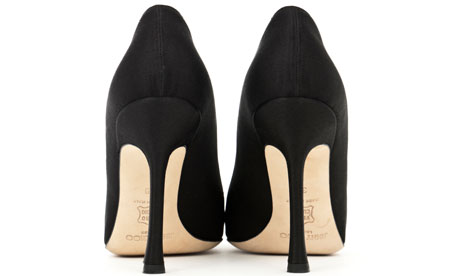Dr Dillner's health dilemmas: should I wear high heels?
They may make your legs look longer, but heels over 3in high carry a health risk

A pair of high heels – not so elegant if you fall over and sprain your ankle. Photograph: Marc Tielemans/Alamy
High heels make your legs look longer and your bottom smaller.
No wonder so many women wear them so much of the time. But a survey of
1,000 women by the shoe company MBT found that more than 40% had
suffered an accident in their high heels – most often from falling over.
Heels more than 3in tall will seriously increase the pressure on the ball of your foot (up to seven times with heels over 3in high) and affect pretty much every part of your lower body as you walk. Still want to wear them?
A paper in the Journal of Experimental Biology showed that women who wear high heels don't distribute weight evenly across their feet but transfer it to the ball of the foot and toes. The women studied developed shorter calf muscles and thicker Achilles tendons, making their feet hurt when they stood flat on the floor and their tendons inflamed and sore.
The American Academy of Orthopaedic Surgeons says that bunions, which are painful swellings on the side of the base of your big toe that can become red and sore, are linked to not only narrow but high-heeled shoes. So are hammer toes, which are painful deformities in which the toes curl up and can't be straightened.
Falling over in heels is both inelegant and, more seriously, can lead to a sprained ankle. High heels also cause lower back pain because it is hard to keep your back aligned when you're tottering around with your centre of gravity artificially pushed forward.
Don't wear high heels as everyday shoes. Limit the time you wear them to no more than five hours. When you walk in heels, glide rather than stomp and put the heel down before the ball of your foot. Wear flat shoes if you have to do any serious walking.
Don't give in to your child's nagging for high heels. The younger girls start wearing them the more risk they have of developing backache and foot problems later in life.
Finally, it has been said that champagne and heels should never mix. You certainly have less far to fall in flats. LINK
Heels more than 3in tall will seriously increase the pressure on the ball of your foot (up to seven times with heels over 3in high) and affect pretty much every part of your lower body as you walk. Still want to wear them?
The dilemma
High heels are fashionable and flattering. But research studies repeatedly show what we already knew: they make your feet hurt and they aren't good for you. A study from Harvard showed that women who wear high heels increase their risk of arthritis of the knee by putting pressure on the inner compartment of the knee joint, compressing and damaging it.A paper in the Journal of Experimental Biology showed that women who wear high heels don't distribute weight evenly across their feet but transfer it to the ball of the foot and toes. The women studied developed shorter calf muscles and thicker Achilles tendons, making their feet hurt when they stood flat on the floor and their tendons inflamed and sore.
The American Academy of Orthopaedic Surgeons says that bunions, which are painful swellings on the side of the base of your big toe that can become red and sore, are linked to not only narrow but high-heeled shoes. So are hammer toes, which are painful deformities in which the toes curl up and can't be straightened.
Falling over in heels is both inelegant and, more seriously, can lead to a sprained ankle. High heels also cause lower back pain because it is hard to keep your back aligned when you're tottering around with your centre of gravity artificially pushed forward.
The solution
Most women wear shoes that are too small for them, which can increase the damage a high heel does to the foot. Make sure your shoes fit – there should be 1cm of room between your big toe and the end of the shoe. You should be able to wriggle your foot and not feel any pressure on the bones on the sides of your feet. Feet do not stay the same size throughout your life, so always try before you buy.Don't wear high heels as everyday shoes. Limit the time you wear them to no more than five hours. When you walk in heels, glide rather than stomp and put the heel down before the ball of your foot. Wear flat shoes if you have to do any serious walking.
Don't give in to your child's nagging for high heels. The younger girls start wearing them the more risk they have of developing backache and foot problems later in life.
Finally, it has been said that champagne and heels should never mix. You certainly have less far to fall in flats. LINK


No comments:
Post a Comment